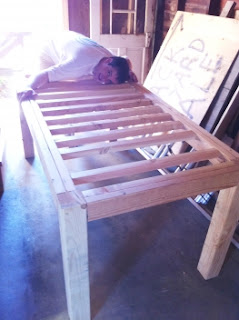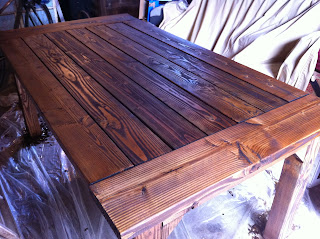A legitimate dining-room table.
Totally serious.
Interested in building a piece of furniture too?
Start here: www.ana-white.com This is one of the coolest websites I've found. Ana has a passion for building things, and for making her plans available for free online so that regular people like me can build our own furniture for WAY cheaper than retail. She also bases many of her designs off name-brand furniture you can buy from Crate & Barrel or West Elm--but for much cheaper.
Find your plan. I used THIS one. The Farmhouse Table Although I'll freely admit that I modified it a bit. I wanted a shorter table with different legs than the original plan (4x4s) instead of 2, 2x4s attached, and no stretcher supports. That meant that I had to modify things so that I could use my post legs without the stretcher supports.
Do all the math and you get something that looks like this:
HINT: Wood is not actually the length it says it is. This was really frustrating. A 4x4 post will actually only measure 3.5x3.5. Take that into account when you're doing your math. My table worked, but in the end, didn't need any of the spacers I planned. And don't use my plan above.... the morning we started cutting & building is when I realized the wood anomaly. This means that the above plan doesn't represent the actual measurements of the wood. Sorry
Then buy your wood (and screws). I got all of mine at Home Depot. Make sure that your boards are SUPER straight. This is really important. We also used 3" AND 4" screws throughout the process. We found out when we got to Home Depot that they don't actually sell 3.5" screws.
And I had to sit in the back with the wood because it was so long.
Then you get out your mighty mighty tape measure, square, and skill saw and start cutting your wood to length. We did wait to cut the tabletop pieces until the end though, just to make sure everything would be the same
HINT: cut the "breadboard" (the two pieces on the end of the tabletop that run perpendicular to the rest of the tabletop) LAST. This measurement was way off, and we ended up having to cut them over again--which meant buying more wood.
Then frame up the legs and sides. We used a pocket hole jig to keep from needing to screw from the outside of the boards. See more about pocket holes HERE. Kreg Jig is just a brand name product--I got an off-brand Home Depot version for cheaper.
Then we built the under-tabletop supports. This piece was just 2, 2x4s with the 2x2 support pieces screwed into them like ladder rungs. Then we set the under-tabletop support piece into the frame we built.
Then screwed the two pieces together. This is Kevin, my table-building model. I also convinced him to do a lot of the actual "power drilling" & "skill sawing" work. He was just so good at it...
Then we turned the whole thing upright and tried to square it. We got to about 1/2" off and called it good.
We measured and screwed in one of the breadboards to the tabletop, and then started on the 7 tabletop pieces that run perpendicular. This was the exciting part.
This is, of course, when I realized that the breadboard pieces were too short (when cut to the exact measurements from Ana White's site--my guess is that the darn, "I'm not actually how long I say I am" wood sizes are the culprit. Regardless, having the one breadboard piece in place made placement of the middle tabletop pieces a lot easier. Then the breadboard piece was removed, a new 2x8 board was purchased, and the new breadboard pieces were cut and screwed into place.
Ta da! Except because I didn't want those stretcher supports underneath, the whole thing was a bit wobbly. So Kevin & I improvised and created some very simple triangle supports for the legs. We just measured and cut from a leftover 2x4 and screwed them into place (after using a level to make sure things were square).
The table-making process took two days (or about 12 hours) to complete. Then I took a week break and started in on the finishing process.
First, I sanded the table to within an inch of its life. I bought a finishing sander from Home Depot and it was worth every penny. I used several grits of sandpaper: 100, 120, and 150. I was afraid to sand too much because I've heard you can essentially "stain" your wood by over-sanding & make it so stain doesn't soak in well. That, and I was sick and tired of staining by that time. It was really smooth to the touch. I counted it good, and then used tack cloth to get ALL the sawdust off.
Wood conditioner is recommended for soft woods like pine (the lumber they generally sell in the regular section at Home Depot). It's essentially two parts paint thinner to one part finish and really helps the soft woods evenly absorb the stain. It closes the wood pores (which are very large on soft wood), so it will absorb less stain just in general--something to keep in mind if you want your project really dark. It also gives the wood (in my opinion) a honey-ish looking color.
Then I tested a piece of wood for the staining process. Six different options: 1) no wood conditioner, stain put on and immediately removed, 2) no wood conditioner, stain put on and left for 10 minutes, 3) wood conditioner wet (or newly applied) and stain put on and immediately removed, 4) wood conditioner wet and stain put on and left for 10 minutes, 5) wood conditioner left to dry overnight and stain put on and immediately removed, and 6) wood conditioner left to dry overnight and stain put on and left for 10 minutes. (Don't automatically just choose the directions from the back of the can--in my research I have found that wood conditioner needs the full 24 hours to dry to work correctly, even though the can says the stain needs to be applied immediately.) For the look I was going for, I chose #6. My stain was an oil-based Minwax Dark Walnut. The wood conditioner gave it a warmer, honey-like tone underneath.
Staining the table was probably my absolutely favorite part of the process. Be sure to put down a tarp to catch all the drops though. And buy some Mineral Spirits beforehand. It'll make the dalmatian look go right away once you're done with the stain. It gets out stain AND polyurethane off skin & brushes, which is really helpful because soap (or dish soap) won't do the trick. Although I've head that cooking/mineral oil will.
Use a rag to rub it on the stain, and an old cotton shirt or sweatshirt to rub it off. Make sure to get all of the stain off afterwards, or it just becomes sticky/tacky and creates more problems when you go to finish the project.
Let the stain dry completely (at least 24-28 hours). Then you can apply another layer of stain if you want. I've heard that past about two coats, your project won't get any darker though. I only did one coat and was really happy with the color.
I did quite a bit of reading on poly. Oil vs. water. (P.S. Never use a water-based stain with an oil-based poly--you can use water over oil, but never oil over water. Check your labels!) It's essentially a plastic coating to furniture, which will protect the wood from spills or liquids. It doesn't have to be too shiny--you can choose from satin, semi-gloss, or gloss finishes to poly. It's not the best finish for all wood projects, but it's a good solid, scratch-resistant, water-proof option for a dining room table (that isn't an "antique").
I did the first layer of oil-based poly (with a foam brush), then let it dry for at least 24 hours. Being sure to use long, slow strokes to make a minimal amount of bubbles. After the first layer dried, the wood was a little rough, so I lightly, hand-sanded with a 220 grit sandpaper (I think any grit lower--e.g. 150--will only scratch the wood too much), wiped everything off with tack cloth, and applied the next layer of poly (and let it dry for another 24 hours). Then sanded with 220 grit again, wiped off with tack cloth, and applied my third and final layer of poly. Now the coating was smooth.
At this point, the table is done! Unfortunately polyurethane takes approximately 2-4 weeks to "cure". It will be dry to the touch in 24 hours, and you can start using it after 7 days, but don't leave anything sitting on it for long periods of time, otherwise it will sink into the poly layer. You can't see it, but apparently the molecules within the poly layer are still moving around, even though the layer feels hard to the touch. I've also heard that it can take up to a year for the poly layer to be completely cured.
So I left my table in my shed for a couple weeks, let it off-gas its VOCs outside, and then got Kevin and my dad to carry it around the mulberry bush and into my house. Where it looks absolutely gorgeous (even without chairs!).
Cost breakdown: Had I bought a brand new, retail 6'x3'(ish) table, it would have probably cost about $1,000. Instead, I spent:
Home Depot wood & screws: $110 (or very close) The 4x4" posts were the most expensive.Such a fun project--even for an amateur--and a totally successful "30 before 30" list achievement (with a whole bunch of stories/memories made in the process).
Pocket hole jig: $30
Power finishing sander & sandpaper: $35
Stain, polyurethane, and foam brushes: $20
TOTAL: About $200














1 comment:
What an amazing job you did, it's just beautiful!
Dining Table Chairs Online
Table N Chairs
Furniture Stores In Denver Colorado
Glass Round Table And Chairs
Post a Comment